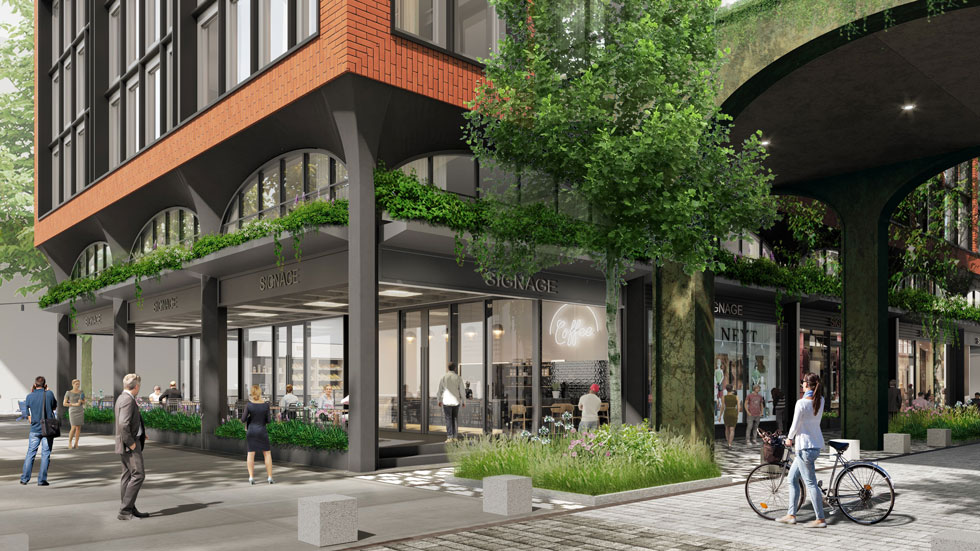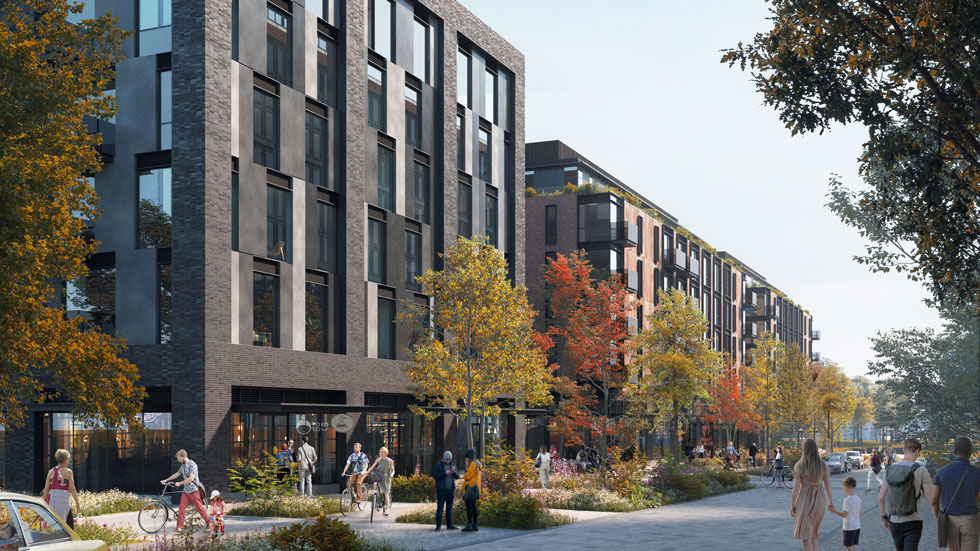An ongoing partnership between JBG SMITH (NYSE: JBGS) and Gallaudet University in Washington, D.C. aims to enhance and improve the unique campus environment of the nation’s leading educational institution for the deaf and hard of hearing, while also bringing it into closer alignment with its surrounding community.
In January 2022, Gallaudet, a private federally chartered research university, and JBG SMITH received final zoning approvals for the first phase of their collaborative Sixth Street Development project. The multi-phase project will develop a series of properties on the western edge of the university’s NoMa (North of Massachusetts Avenue) campus, creating mixed-use development and broadening Gallaudet’s interaction with the surrounding Washington, D.C. community.
Phase one includes three buildings totaling approximately 760,000 square feet of multifamily residential, 60,000 square feet of retail, and 17,000 square feet of university spaces.
“Gallaudet University has been around for 150 years, so we think in terms of centuries,” says Sam Swiller, director of strategic real estate planning, business development, and external relations for Gallaudet. “In the last two decades the university has become much more ambitious about how it wanted to face the world,” he says.
The arrival of the NoMa-Gallaudet metro station (thencalled New York Ave–Florida Ave– Gallaudet) in 2004 spurred a wave of new development and opportunity in the area. Historically, Gallaudet had been physically and in many ways socially—isolated from the surrounding area, though it had always played a vital role in the city’s community. The university decided that this was the right time to take agency over its land holdings and future development in order to realize its goal of increasing student interaction with the surrounding community, which includes the popular Union Market specialty food hall.
Beginning in 2014, it partnered with JBG SMITH. The Sixth Street Development includes four parcels of land and three phases, each with unique designs and approaches to achieving their joint goals.
“This project really allows Gallaudet to engage with this burgeoning Union Market neighborhood on its own terms, striking a balance with engagement, and preserving its unique campus environment,” says Robbie Saclarides, vice president of development at JBG SMITH.
JBG SMITH is also delivering approximately 150 affordable housing units across the project. The majority will be offered at the 50% MFI (median family income) level, the deepest level of affordability contemplated in Washington, D.C.’s Inclusionary Zoning Program.
Historic Roots
What would become Gallaudet University was established in 1864 when President Abraham Lincoln signed a bill into law after Congress authorized the institution to confer college degrees.
During its first commencement in 1869, diplomas were signed by President Ulysses S. Grant. Current presiding U.S. presidents continue the practice to this day. From its inception, Gallaudet has focused on advances in education of deaf and hard of hearing students and advocating for deaf rights worldwide.
Over the last 150 years, Gallaudet has evolved, becoming the leading institution for the education of deaf and hard of hearing, offering 40 majors for undergraduate degrees. The university also admits a small number of hearing, degree-seeking students. Graduate programs are open to deaf, hard of hearing, and hearing students. The university has roughly 22,000 alumni around the world.
“It’s a special place,” says Swiller, who identifies as hard of hearing but says he hadn’t learned American Sign Language (ASL) prior to first visiting the campus in 2009. “It was an eye-opening experience,” he recalls. When he first arrived at Gallaudet, Swiller taught classes, bringing his professional experience in real estate private equity to students before taking up his current role at the university.
Gallaudet employs ASL and written English for instruction. The campus represents the largest collection of ASL speakers in the world, so preserving and advancing its mission presented a unique set of challenges and opportunities for development.
Some of these include transitioning from a more pastoral campus to a more urban one, consolidating the university’s footprint to increase student interactions, orienting campus around a central heart, and building bridges between the campus and the larger community.
According to Swiller, the university faced a pivotal question: “How do we model a path for students to face the outside world and provide them with the best tools to meet the world on their terms?” To achieve its goals, the university created a real estate foundation to oversee its real estate activity and has conducted years of research to help answer this question.
Finding Partnership
The university also wanted to generate a stream of reliable cash to put to work in enhancing amenities for students, faculty, and staff, but selecting a developer presented its own risks.
“We were deeply concerned that whatever developer we brought on would be attentive to the needs of our school that focuses on the deaf and hard of hearing, which historically is a marginalized population,” Swiller says.
In 2012, Gallaudet launched an extensive request for proposal (RFP) process. Choosing from roughly 40 candidates, Gallaudet selected then-JBG Companies and finalized agreements in 2014. According to Swiller, JBG appealed to the university because it was a private developer with a great track record and financial capabilities, and it showed a deep understanding and respect for Gallaudet’s history and legacy.
JBG SMITH becoming a REIT in 2017 only added to their appeal, Swiller says, because they are long-term investors.
“As a REIT, we’re a long term holder which underpins our decision-making and I think Gallaudet is similarly a long term thinker, having been here since 1864,” Saclarides says. Sharing long-term visions helped when plans for Sixth Street were delayed for several years by a local lawsuit that was ultimately dismissed. The Sixth Street Development also fits well within JBG SMITH’s portfolio, which targets high-growth, transit-oriented markets.
“It’s been a lengthy, collaborative process that helped to establish the strong foundation of trust and understanding between the two parties,” Saclarides notes. “We’re working to get our first shovels in the ground, and we’ve been together every step of the way,” she adds.
The project has also involved collaboration with multiple public and private entities including district officials from the Department of Transportation, D.C. Water, D.C. Zoning Commission, as well as the community organizations such as the local Advisory Neighborhood Commission.
Gallaudet students and staff were also involved in identifying and selecting developers and throughout the process.
Unique Design
Design and architecture have provided another unique space for collaboration between JBG SMITH and Gallaudet.
The Sixth Street Project will employ DeafSpace Guidelines, more than 150 distinct architectural design elements developed by the DeafSpace Project, a collaboration between Gallaudet and architect Hansel Bauman. The guidelines address key touch points between deaf experiences and the built environment: space and proximity, sensory reach, mobility and proximity, light and color, and acoustics.
DeafSpace design also focuses on community building, visual language, and the promotion of personal safety and well-being. Built on long-held cultural traditions, Gallaudet research, and the latest architectural developments, DeafSpace accounts for challenges like poor lighting conditions—such as glare and backlighting—that interrupt visual communication.





